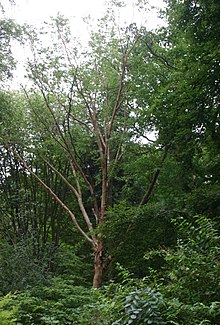Betula albosinensis
| Betula albosinensis | |
|---|---|

| |
| Chinese red birch | |
| Scientific classification | |
| Kingdom: | Plantae |
| Clade: | Tracheophytes |
| Clade: | Angiosperms |
| Clade: | Eudicots |
| Clade: | Rosids |
| Order: | Fagales |
| Family: | Betulaceae |
| Genus: | Betula |
| Subgenus: | Betula subg. Neurobetula |
| Species: | B. albosinensis
|
| Binomial name | |
| Betula albosinensis | |
Betula albosinensis, commonly known as the Chinese red birch, is a species of birch in the family Betulaceae, native to Western China. It is notable for its distinctive peeling bark and is cultivated as an ornamental tree.
Description
[edit]Betula albosinensis is a deciduous tree that can grow up to 25 m (82 ft) in height,[2] with some specimens reaching 18 to 27 m (60 to 90 ft).[3] The trunk can reach a circumference of 1.8 to 3.4 m (6 to 11 ft).[3]
Bark
[edit]A distinctive feature is the red birch's peeling bark, which is brown but cream when newly exposed.[2] The bark has been described as bright orange to orange-red, peeling off in very thin sheets. Each new layer of bark is covered with a white glaucous bloom, giving it a unique appearance.[3]
Leaves
[edit]The leaves are ovate, 5 to 7.6 cm (2 to 3 in) long and 2.5 to 3.8 cm (1 to 1.5 in) wide, with a slender point and rounded base. They have unevenly jagged teeth along the edges and 9 to 14 pairs of veins. Young leaves have hair between the veins, becoming smooth (glabrous) with age.[3]
Catkins
[edit]Brown catkins are produced in Spring.[2] Male catkins are 3.8 to 6.4 cm (1.5 to 2.5 in) long, while female catkins are 2.5 to 3.8 cm (1 to 1.5 in) long and about 8 mm (1/3 in) wide. Female catkins are usually solitary, sometimes in pairs.[3]
Other features
[edit]Young shoots are slightly glandular, becoming dark brown and smooth with scattered warts as they age.[3]
Taxonomy
[edit]Betula albosinensis was first described by Burkill in 1899 in the Journal of the Linnean Society.[4] The Latin specific name albosinensis means "white, from China".[5]
Synonyms include B. bhojpattra var. sinensis and B. utilis var. sinensis.[6]
Recent taxonomic revisions have proposed reclassifying this taxon as Betula utilis subsp. albosinensis (Burkill) Ashburner & McAll. This reclassification was published in Ashburner & McAllister's 2013 work "The genus Betula: a taxonomic revision of birches".[7] This classification is accepted by the World Flora Online (WFO) and Plants of the World Online (POWO).[6][8]
Distribution and habitat
[edit]Betula albosinensis is native to Western China.[1] More specifically, it is found in North-Central China, South-Central China, Southeast China, and Inner Mongolia. It grows primarily in temperate biomes.[6]
Uses
[edit]Cultivation
[edit]Betula albosinensis is grown as an ornamental tree for parks and large gardens, valued for its striking bark.[3] It was first introduced to cultivation in the West by E.H. Wilson in 1901, who collected specimens in Western Hupeh (now Hubei) province.[3]
Numerous cultivars have been produced. The cultivars 'Fascination'[9] and 'Red Panda'[10] have gained the Royal Horticultural Society's Award of Garden Merit.
Gallery
[edit]References
[edit]- ^ a b "Betula albosinensis". The Plant List. Retrieved 22 January 2018.
- ^ a b c RHS A-Z encyclopedia of garden plants. United Kingdom: Dorling Kindersley. 2008. p. 1136. ISBN 978-1405332965.
- ^ a b c d e f g h Trees and Shrubs Online. Betula albosinensis. https://www.treesandshrubsonline.org/articles/betula/betula-albosinensis/
- ^ Linnean Society of London.; London, Linnean Society of (1889). The Journal of the Linnean Society. Botany. Vol. v.26 (1889-1890). London : the Society: Longman, Green, Longman, Roberts & Green.
- ^ Harrison, Lorraine (2012). RHS Latin for Gardeners. United Kingdom: Mitchell Beazley. ISBN 978-1845337315.
- ^ a b c Plants of the World Online (POWO). Betula utilis subsp. albosinensis. https://powo.science.kew.org/taxon/urn:lsid:ipni.org:names:77128714-1
- ^ Ashburner, K. & McAllister, H.A. (2013). The genus Betula: a taxonomic revision of birches: 1-431. Royal Botanic Gardens, Kew.
- ^ World Flora Online (WFO). Betula utilis subsp. albosinensis. https://wfoplantlist.org/taxon/wfo-0001362561-2024-06
- ^ "Betula 'Fascination'". RHS. Retrieved 12 April 2020.
- ^ "RHS Plantfinder - Betula albosinensis 'Red Panda'". Royal Horticultural Society. Retrieved 21 January 2018.



